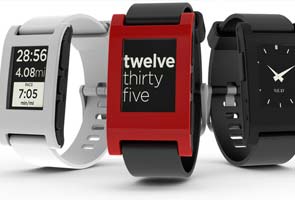- Home
- Others
- Others News
- Pebble wristwatches will display information from iPhones
Pebble wristwatches will display information from iPhones
By Jenna Worthan, The New York Times | Updated: 5 June 2012 13:54 IST

Click Here to Add Gadgets360 As A Trusted Source

Advertisement
When Eric Migicovsky, an engineer, wanted to develop a line of wristwatches that could display information from an iPhone - like caller ID and text messages - he went the traditional route of asking venture capitalists to finance his company.
But he couldn't even get a foot in the door, let alone secure any money for what he called the Pebble watch.
So he turned to Kickstarter, a site where ordinary people back creative projects. Backers could pledge $99 and were promised a Pebble watch in return.
Less than two hours after the project went up on the site, Mr. Migicovsky and his partners hit their goal of $100,000.
"By that night, we were at $600,000," said Mr. Migicovsky, who is 25 and a recent engineering graduate of the University of Waterloo. "We went out for a beer to celebrate, went home and slept, and when we woke up, we were at a million dollars."
As of Friday afternoon, nearly 50,000 people had pledged close to $7 million - and there is still two weeks left before the fund-raising window closes. (As of Sunday afternoon, the total had passed $7 million.)
Pebble is the latest - and by far the largest - example of how Kickstarter, a scrappy start-up sprouted in the New York living room of its founders three years ago, is transforming the way people build businesses.
Although the site first began as a way for people to raise money for quirky projects like pop-up wedding chapels, around-the-world boating trips and offbeat documentaries, it quickly expanded to include video game production, feature films and innovative new gadgets, like the Elevation dock, a sleek stand for the iPhone, or Brydge, which turns an iPad into a laptop resembling the MacBook Air.
The large amount of money that Pebble has raised - equivalent to what a young company would get in a second round of venture capital financing - also signifies a coming of age for Kickstarter.
"This year marks the year that we've seen Kickstarter enter the real world in a number of ways," said Perry Chen, one of its founders. "At Tribeca Film Fest, there are a dozen different Kickstarter-backed films, there's an installation at the Whitney Biennial that was a Kickstarter project and we just had our birthday party at a Kickstarter-funded restaurant."
Much as the introduction of cheap Web services lowered the barrier to entry for people seeking to create a start-up, and as offshore manufacturing gave entrepreneurs a chance to make products without having to build a factory, Kickstarter offers budding entrepreneurs a way to float ideas and see if there's a market for them before they trade ownership of their company for money from venture capitalists.
Mr. Migicovsky and his partners did not have to give up any portion of their company to the venture capitalists. They still own 100 percent of it.
"Kickstarter is already proving to be a viable alternative to starting a company the traditional way," said David H. Hsu, an associate professor at the Wharton School at the University of Pennsylvania who studies entrepreneurship and innovation.
"You're activating a user base that you know will be interested in your project," he said. "Which, historically, has always been the biggest trouble for crowdfunding sites, getting traction and critical mass." As Kickstarter prospers, other sites for financing through a crowd have appeared. There's Crowdtilt, a service that lets friends contribute money for outings like a beach vacation; Zokos, a start-up that gives guests a way to pitch in for a dinner party; and Gambitious, a financing site devoted to indie game developers, to name a few.
But Kickstarter is the biggest. To date, it has raised more than $200 million for 20,000 projects, or about 44 percent of those that sought financing on the site. Only projects that meet their stated financing goals receive money.
Patrons who back Kickstarter campaigns are often rewarded with insider access to the projects they finance, and in most cases, a tangible reward for their money. In Pebble's case, the reward is an actual watch, making it a more appealing project than, say, a movie, where the payoff is a little harder to show off to friends.
Kickstarter does not charge anything to set up a campaign. But if it is successful, Kickstarter takes 5 percent of the final amount. Amazon, which processes the payments, takes 3 to 5 percent.
Mr. Migicovsky says he suspected that the Pebble project might be a runaway success. "The plan," he said, "was always to go big."
Before introducing the project on Kickstarter, Mr. Migicovsky says he sought advice from previous successful project founders on Kickstarter, including the creators behind Twine, colorful blocks outfitted with sensors and Internet connectivity, that blew past its original goal of $35,000 to raise more than $500,000 - an anomaly considering that the average Kickstarter project size hovers around $5,000.
"They all told us not to focus on the hacker market because they are already going to love you," he said. "But how can you tell people who have no idea what this is why they should back it?"
A carefully made video helped to earn the trust of their backers. Mr. Migicovsky also played up his four years of experience building smartwatches - previously for BlackBerry products - and his time polishing his ideas in Y Combinator, a technology incubator in Palo Alto, Calif. Mr. Migicovsky also worked to broaden the appeal of the watch beyond a tech-focused audience by working with a company called RunKeeper that helps people track their jogs on their smartphones.
Before approaching Kickstarter, he had tapped the know-how of Dragon Innovation, a team of production consultants with experience working on the Roomba at iRobot. But he ran out of money. He called them again after Kickstarter raised the first $1 million. The consultants at Dragon told him they had already noticed.
Although the most common projects on Kickstarter tend to revolve around film and music, the service has been particularly useful for new types of hardware products.
Traditionally, venture capitalists are skittish about putting money into hardware start-ups because it is so complicated. "Even at that scale investment and with a company that is very experienced taking a product to market, they hit pitfalls," said Robert Fabricant, a vice president of Frog Design, a development firm that helps create products.
Mr. Fabricant, like others in his field, cast some doubt on the notion that it was possible to sidestep the traditional routes to building a business, particularly through a service like Kickstarter. They say young, inexperienced business people need advisers, mentors and a network of support to help them deal with the problems that can emerge. There is a big difference between a project and a product strong enough to sustain a full-fledged business, they say, and it is risky to confuse the two.
The founders of Kickstarter say they draw a firm line between a project and a business. "With the more consumer-oriented projects, we make sure it's very clear backers know they're helping build a project and they will get one as their reward," said Yancey Strickler, another Kickstarter founder. "They are intended to be finite projects, but you do find things that start off with a small idea and grow into something quite large."
But Gleb Polyakov and Igor Zamlinsky, two young entrepreneurs from Atlanta who are trying to create a full-blown company around a $400 barista-grade home espresso machine, say that risk is no different than for traditional small businesses.
"The terms on Kickstarter are more attractive than any bank loan or venture capital amount," Mr. Polyakov said. "If you can get funding through Kickstarter, there is no reason not to."
But he couldn't even get a foot in the door, let alone secure any money for what he called the Pebble watch.
So he turned to Kickstarter, a site where ordinary people back creative projects. Backers could pledge $99 and were promised a Pebble watch in return.
Less than two hours after the project went up on the site, Mr. Migicovsky and his partners hit their goal of $100,000.
"By that night, we were at $600,000," said Mr. Migicovsky, who is 25 and a recent engineering graduate of the University of Waterloo. "We went out for a beer to celebrate, went home and slept, and when we woke up, we were at a million dollars."
As of Friday afternoon, nearly 50,000 people had pledged close to $7 million - and there is still two weeks left before the fund-raising window closes. (As of Sunday afternoon, the total had passed $7 million.)
Pebble is the latest - and by far the largest - example of how Kickstarter, a scrappy start-up sprouted in the New York living room of its founders three years ago, is transforming the way people build businesses.
Although the site first began as a way for people to raise money for quirky projects like pop-up wedding chapels, around-the-world boating trips and offbeat documentaries, it quickly expanded to include video game production, feature films and innovative new gadgets, like the Elevation dock, a sleek stand for the iPhone, or Brydge, which turns an iPad into a laptop resembling the MacBook Air.
The large amount of money that Pebble has raised - equivalent to what a young company would get in a second round of venture capital financing - also signifies a coming of age for Kickstarter.
"This year marks the year that we've seen Kickstarter enter the real world in a number of ways," said Perry Chen, one of its founders. "At Tribeca Film Fest, there are a dozen different Kickstarter-backed films, there's an installation at the Whitney Biennial that was a Kickstarter project and we just had our birthday party at a Kickstarter-funded restaurant."
Much as the introduction of cheap Web services lowered the barrier to entry for people seeking to create a start-up, and as offshore manufacturing gave entrepreneurs a chance to make products without having to build a factory, Kickstarter offers budding entrepreneurs a way to float ideas and see if there's a market for them before they trade ownership of their company for money from venture capitalists.
Mr. Migicovsky and his partners did not have to give up any portion of their company to the venture capitalists. They still own 100 percent of it.
"Kickstarter is already proving to be a viable alternative to starting a company the traditional way," said David H. Hsu, an associate professor at the Wharton School at the University of Pennsylvania who studies entrepreneurship and innovation.
"You're activating a user base that you know will be interested in your project," he said. "Which, historically, has always been the biggest trouble for crowdfunding sites, getting traction and critical mass." As Kickstarter prospers, other sites for financing through a crowd have appeared. There's Crowdtilt, a service that lets friends contribute money for outings like a beach vacation; Zokos, a start-up that gives guests a way to pitch in for a dinner party; and Gambitious, a financing site devoted to indie game developers, to name a few.
But Kickstarter is the biggest. To date, it has raised more than $200 million for 20,000 projects, or about 44 percent of those that sought financing on the site. Only projects that meet their stated financing goals receive money.
Patrons who back Kickstarter campaigns are often rewarded with insider access to the projects they finance, and in most cases, a tangible reward for their money. In Pebble's case, the reward is an actual watch, making it a more appealing project than, say, a movie, where the payoff is a little harder to show off to friends.
Kickstarter does not charge anything to set up a campaign. But if it is successful, Kickstarter takes 5 percent of the final amount. Amazon, which processes the payments, takes 3 to 5 percent.
Mr. Migicovsky says he suspected that the Pebble project might be a runaway success. "The plan," he said, "was always to go big."
Before introducing the project on Kickstarter, Mr. Migicovsky says he sought advice from previous successful project founders on Kickstarter, including the creators behind Twine, colorful blocks outfitted with sensors and Internet connectivity, that blew past its original goal of $35,000 to raise more than $500,000 - an anomaly considering that the average Kickstarter project size hovers around $5,000.
"They all told us not to focus on the hacker market because they are already going to love you," he said. "But how can you tell people who have no idea what this is why they should back it?"
A carefully made video helped to earn the trust of their backers. Mr. Migicovsky also played up his four years of experience building smartwatches - previously for BlackBerry products - and his time polishing his ideas in Y Combinator, a technology incubator in Palo Alto, Calif. Mr. Migicovsky also worked to broaden the appeal of the watch beyond a tech-focused audience by working with a company called RunKeeper that helps people track their jogs on their smartphones.
Before approaching Kickstarter, he had tapped the know-how of Dragon Innovation, a team of production consultants with experience working on the Roomba at iRobot. But he ran out of money. He called them again after Kickstarter raised the first $1 million. The consultants at Dragon told him they had already noticed.
Although the most common projects on Kickstarter tend to revolve around film and music, the service has been particularly useful for new types of hardware products.
Traditionally, venture capitalists are skittish about putting money into hardware start-ups because it is so complicated. "Even at that scale investment and with a company that is very experienced taking a product to market, they hit pitfalls," said Robert Fabricant, a vice president of Frog Design, a development firm that helps create products.
Mr. Fabricant, like others in his field, cast some doubt on the notion that it was possible to sidestep the traditional routes to building a business, particularly through a service like Kickstarter. They say young, inexperienced business people need advisers, mentors and a network of support to help them deal with the problems that can emerge. There is a big difference between a project and a product strong enough to sustain a full-fledged business, they say, and it is risky to confuse the two.
The founders of Kickstarter say they draw a firm line between a project and a business. "With the more consumer-oriented projects, we make sure it's very clear backers know they're helping build a project and they will get one as their reward," said Yancey Strickler, another Kickstarter founder. "They are intended to be finite projects, but you do find things that start off with a small idea and grow into something quite large."
But Gleb Polyakov and Igor Zamlinsky, two young entrepreneurs from Atlanta who are trying to create a full-blown company around a $400 barista-grade home espresso machine, say that risk is no different than for traditional small businesses.
"The terms on Kickstarter are more attractive than any bank loan or venture capital amount," Mr. Polyakov said. "If you can get funding through Kickstarter, there is no reason not to."
© 2012, The New York Times News Service
Comments
Catch the latest from the Consumer Electronics Show on Gadgets 360, at our CES 2026 hub.
Related Stories
Popular on Gadgets
- Samsung Galaxy Unpacked 2025
- ChatGPT
- Redmi Note 14 Pro+
- iPhone 16
- Apple Vision Pro
- Oneplus 12
- OnePlus Nord CE 3 Lite 5G
- iPhone 13
- Xiaomi 14 Pro
- Oppo Find N3
- Tecno Spark Go (2023)
- Realme V30
- Best Phones Under 25000
- Samsung Galaxy S24 Series
- Cryptocurrency
- iQoo 12
- Samsung Galaxy S24 Ultra
- Giottus
- Samsung Galaxy Z Flip 5
- Apple 'Scary Fast'
- Housefull 5
- GoPro Hero 12 Black Review
- Invincible Season 2
- JioGlass
- HD Ready TV
- Laptop Under 50000
- Smartwatch Under 10000
- Latest Mobile Phones
- Compare Phones
Latest Gadgets
- Vivo Y500i
- OnePlus Turbo 6V
- OnePlus Turbo 6
- Itel Zeno 20 Max
- OPPO Reno 15 Pro Mini 5G
- Poco M8 Pro 5G
- Motorola Signature
- Vivo Y50e 5G
- Lenovo Yoga Slim 7x (2025)
- Lenovo Yoga Slim 7a
- Realme Pad 3
- OPPO Pad Air 5
- Xiaomi Watch 5
- Huawei Watch 10th Anniversary Edition
- Acerpure Nitro Z Series 100-inch QLED TV
- Samsung 43 Inch LED Ultra HD (4K) Smart TV (UA43UE81AFULXL)
- Asus ROG Ally
- Nintendo Switch Lite
- Haier 1.6 Ton 5 Star Inverter Split AC (HSU19G-MZAID5BN-INV)
- Haier 1.6 Ton 5 Star Inverter Split AC (HSU19G-MZAIM5BN-INV)
© Copyright Red Pixels Ventures Limited 2026. All rights reserved.

















